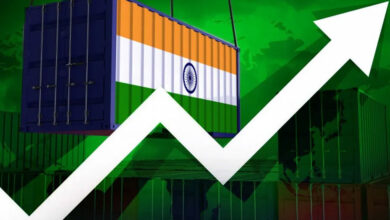Decrypting the Defence Tech Opportunity in India
By R. Anil Kumar
- India through its “Make in India” initiative aims to reduce its reliance on imports of defence equipment and technology and increase its defence exports to seize a share of the $2.1 Trillion global defence market
Bangalore, August 16. India is embarking on a new path to boost its defence and improve its capabilities through the “Make in India” initiative.

The country aims to reduce its reliance on imports of defence equipment and technology and increase its defence exports to seize a share of the $2.1 Trillion global defence market.
India today accounts for 3.7% of global military spending, making it the third highest military spender ($76.6 Bn in 2022) in the world after the U.S. and China
The “Make in India” initiative aims to encourage the indigenous production of defence equipment by established firms as well as emerging startups and SMEs through tax incentives and favourable policies.
Additionally, the Indian government has also launched the Innovation for Defence Excellence (IDEX) programme to foster innovation and promote startups in the defence sector.
Rising India: Transforming Defence Landscape
India today accounts for 3.7% of global military spending, making it the third highest military spender ($76.6 Bn in 2022) in the world after the U.S. ($801 Bn) and China ($293 Bn).
It is also the second largest defence force in the world, with 14 Lakh active personnel and 13 Lakh reserve personnel across the Indian Army, Navy and Air Force. Defence expenditures constitute nearly 2.4% of GDP.
Until a few decades ago, India’s ability to meet its expenses was less than 20%. In fact, India was the largest importer in the defence sector until about eight years ago.
It is a paradox that while India has one of the largest defence industrial complexes in the developing world, yet it continues to be overwhelmingly dependent on imports for arms and equipment.
But now, time is changing. India’s defence manufacturing sector is maturing, with both established and emerging players of various sizes gearing up to seize the lucrative opportunities in the defence and aerospace industries that they have been anticipating for years.
According to senior officials in the Ministry, this is due to India’s plan to invest an average of INR 1.5 Lakh Cr ($18.3 Bn) per year until 2030 in order to modernise its military capabilities.
At the same time, the government is taking strong measures to increase domestic procurement.
The Ministry of Defence (MoD) previously released three positive indigenisation lists, which included a total of 310 items that must be sourced domestically and contain at least 50% domestic content.
During the opening ceremony of DefExpo 2022 in Gandhinagar, Gujarat on October 19, 2022, Prime Minister Narendra Modi had announced the fourth positive indigenisation list, which consists of 101 items to be sourced domestically.
This step by the government has been a big catalyst to encourage domestic companies to invest and build capabilities either organically or through technology transfers with global Original Equipment Manufacturers (OEMs).

The emphasis is not only on reducing defence equipment imports, but also on increasing India’s exports of defence equipment and technology by relaxing export regulations, encouraging public-private partnerships, and inviting global delegations from emerging countries to consider India as a defence supplier.
In March 2023, the Indian government invited army chiefs or their representatives from 31 African nations to showcase the capability of the Indian defence industry at the maiden India Africa Army Chiefs Conclave in Pune. India is now exporting to over 85 countries, according to a recent statement by the Ministry of Defence.
“Defence exports have now grown eight times in the past five years. India’s defence exports in 2021-22 have touched INR 13,000 Cr ($1.6 Bn). And in the coming years, India has set itself a target to reach INR 40,000 Cr ($5 Bn)” Said PM Modi in the DefExpo 2022.
The private sector defence manufacturing ecosystem has seen a surge of pioneering energy after the $128 Bn opportunity that is expected to be available over the next seven years.
However, it’s still possible that this figure is an underestimate. In the upcoming fiscal year of FY24, the capital outlay for defence modernisation and infrastructure development is projected to be INR 1.63 Lakh Cr ($20 Bn).
As a result of various systemic events influencing global factors and major changes in defence procurement policy by the Government of India, we see four major trends:
- High defence expenditure as a percentage of GDP
- The economic substitution of expensive foreign inputs with Indian alternatives
- The significant growth of defence exports from India
- Scale-up of defence startups and SMEs who will seize the opportunity through differentiated technology or products and partnerships with larger system integrators
What’s In There for Startups: The Struggle to Succeed
Every day, the major private companies in India make headlines. Tata Advanced Systems, a Tata Group subsidiary that develops and manufactures aerospace, defence, and security products, recently collaborated with Airbus Defence & Space (DS), a division of Airbus, to manufacture and assemble the C-295 medium-lift transport aircraft.
The deal worth INR 21,935 Cr ($2.67 Bn) for producing 40 fly-away C-295 aircraft and providing MRO (maintenance, repair and operations) services for 56 aircraft is considered to be the biggest development since the involvement of the private sector in the Indian defence industry.

Bharat Forge’s order book, which primarily comprises guns and mounted vehicles, exceeds INR 2,000 Cr ($240 Mn). Meanwhile, Mahindra Defence Systems is currently executing an order worth INR 1,056 Cr ($129 Mn) for light combat vehicles from the army and another order worth INR 1,350 Cr ($165 Mn) from the navy for an integrated anti-submarine warfare defence suite.
This clearly shows that the large defence conglomerates are already playing a significant role in achieving the goal of the “Make in India” initiative, but what is the contribution of emerging startups and SMEs in this sector? Despite the fact that the defence industry is booming, only a few defence startups have emerged in recent years. Let’s explore why this is the case.
Strict Regulations and Standards
India’s defence sector is subject to strict regulations and standards like industrial licencing, security clearances and defence procurement policies, among others. All of which defence startups must adhere to. Moreover, the procurement process for defence equipment is intricate and lengthy, posing a challenge for startups with limited resources.
Additionally, the defence sector demands substantial investment, which can be a hurdle for startups, whether it’s equity or debt funding. Even when startups succeed in getting orders, raising working capital finance is still a challenge due to the limitations of the Indian banking system in lending to loss-making companies.
The government is aware of the challenges faced by these defence startups and has rolled out initiatives such as Innovations for Defence Excellence (iDEX) under the “Make in India” programme to address these challenges and create a more balanced ecosystem.
Shielding Defence Startups: Government Schemes To Overcome These Challenges
With the “Make in India” initiative and the iDEX programme, the government is attempting to lower entry barriers for defence startups in India and provide them with a level playing field.
Make in India
The “Make in India” initiative aims to increase domestic defence production from 54% in 2019 to 75% by 2024, and it has created a supportive ecosystem for domestic manufacturers, opening up new markets for startups, with the government’s procurement process prioritising indigenous products.

The government has banned the import of 411 weapons, platforms, and systems, which will be indigenised in phases from 2022 to 2030. This ban includes high-value imports such as lightweight tanks, naval utility helicopters, artillery guns, various missiles, destroyers, light combat, transport and basic trainer aircraft, as well as other lower-value imports like spare parts.
Moreover, the government has released three lists of 3,738 components that are imported by defence public sector undertakings (DPSUs) worth INR 39,000 Cr ($4.75 Bn) per year. The majority of these components will be indigenised in the coming years, and 25% of them will be reserved for the private sector.
iDEX
Well aware of the shortcomings of traditional domestic defence contractors, the Indian government also set up a novel programme in 2018 called iDEX, or Innovations for Defence Excellence, under the Make in India programme.
The scheme, with budgetary support of INR 500 Cr ($60 Mn) for the next five years (from 2021-22 to 2025-26) is aimed at providing financial support to nearly 300 startups, MSMEs, individual innovators and 20 partner incubators. The initiative has introduced several schemes and programmes to support defence startups, including:
Defence India Startup Challenge (DISC): A programme that aims to identify and support startups and innovators with disruptive defence technologies.
In February 2023, the Defence Minister launched the ninth edition of the Defence India Startup Challenges (DISC 9) programme, which focuses on cybersecurity and offers 28 problem statements. Additionally, he has inaugurated the iDEX Investor Hub, which has received pledges of over INR 200 Cr from prominent Indian investors.
Defence Innovation Organisation (DIO): iDEX is funded and managed by a “Defence Innovation Organisation (DIO)” formed as a “not-for-profit” company in accordance with Section 8 of the Companies Act 2013. It was established to promote innovation and technology development in the defence sector.
Technology Development Fund (TDF): A fund that provides financial support to startups and innovators to develop defence technologies. In June 2022, the Defence Minister approved the enhancement of funding under the TDF scheme of the MoD to INR 50 Cr per project from INR 10 Cr.

Breaking Barriers: Success Stories Of Defence Startups
These initiatives have helped several defence startups in India scale fast, develop their products and technology and win orders from the defence forces.
According to a report by Inc42, in 2020, there were 194 defence technology startups operating in India under the Startup India mission, with 44 of them actively participating in the iDEX initiative. Now the number has grown to more than 300 defence startups, having received grants worth more than INR 200 Cr from the iDEX.





